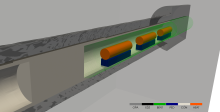Wanted: a site deep underground that will remain sealed for a million years. Radioactive waste is to be safely stored in repositories after the shutdown of nuclear power plants. One of the foundations for the authorities' search process is geotechnical safety analyses using special calculation software. A team from the TU Bergakademie Freiberg and its partners is investigating how this software can be expanded to provide information about the properties of the subsurface even with incomplete knowledge.
In the international underground laboratory Mount Terri in Switzerland, non-hazardous electrically heated containers have been stored in deep layers of clay instead of real radioactive waste for research purposes for decades. "The geotechnical calculations for the safety of a repository are not just about radioactivity, but also about temperature. The disposal containers emit heat, which can generate temperatures of around 100 degrees Celsius in the area surrounding the containers. The rock must not be unacceptably damaged in order to ensure the long-term containment of the radioactive substances," explains geotechnics professor Thomas Nagel. His team has now analysed the long-term data from the Swiss laboratory for the first time using the improved calculation software for geotechnical safety analyses.
Including different forecasts: Improved software available for authorities
As with weather and climate models, geotechnical safety analyses need to examine different variants and ranges of probable developments. "By analysing the data using probability calculation methods, we now have a better understanding of how parameter uncertainties on the one hand and geotechnical characteristics of the mine on the other influence the prediction of damage to the rock mass. The calculation software has not yet been able to calculate this in such detail for large areas of the rock," says the geotechnical engineer.
For the expansion, the Freiberg geotechnical engineers worked together with the UFZ Leipzig, the Federal Institute for Geosciences and Natural Resources and Chemnitz University of Technology. The improved simulation methods are now available to authorities and other users in open source software. In order to present the complex issues as intuitively as possible, the team developed interactive visual representations of the results. This allows interested parties to see how changes to individual input values in the calculations affect temperature or rock stress.
"We can - and don't have to - predict with any degree of precision how a repository will develop over a million years. But we need to expand the calculation software so that researchers and authorities can estimate how accurate the results of the calculation actually are. Uncertainty regarding the values of certain parameters does not mean that a repository as such is unsafe. It merely means that we have to work with ranges and probabilities of possible developments. Taking uncertainty into account in geotechnical safety analyses can thus improve the interpretability of the results for authorities and make them more trustworthy for the public."
Background: URS research network
Over the past three years, the Chair of Soil Mechanics and Foundation Engineering at TU Bergakademie Freiberg has coordinated the research network URS (Uncertainties and Robustness with a View to the Safety of a Repository for High-Level Radioactive Waste), in which numerous researchers from 18 institutions have worked together. A total of 17 doctoral students were trained in a research training group. The network was initiated and financed by the Federal Company for Final Disposal (BGE). It comprised six research projects, including the MeQUR cluster project of TU Bergakademie Freiberg and TU Chemnitz, the Helmholtz Centre for Environmental Research and the Federal Institute for Geosciences and Natural Resources (BGR).
